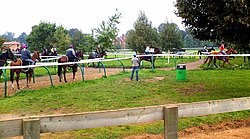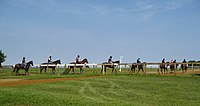Newmarket
| Newmarket | |
| Suffolk | |
|---|---|
 The Severals Newmarket | |
| Location | |
| Grid reference: | TL645636 |
| Location: | 52°14’45"N, 0°24’38"E |
| Data | |
| Population: | 14,995 (2001) |
| Post town: | Newmarket |
| Postcode: | CB8 |
| Dialling code: | 01638 |
| Local Government | |
| Council: | West Suffolk |
| Parliamentary constituency: |
West Suffolk |
Newmarket is a market town in Suffolk, famous for horse racing, a sport and industry which dominates the town and the fields for many miles around. Newmarket is generally considered the birthplace and global centre of thoroughbred horse racing. It is the largest racehorse training centre in Britain, and home to most major British horseracing institutions. Nine of the UK's 32 Group 1 flat races are held at Newmarket, the same number as at Ascot Racecourse. It has two racetracks, The Rowley Mile and The July Course.
The town lies in a "bubble" of Suffolk containing Newmarket and Exning which is surrounded by Cambridgeshire and joined to the main body of Suffolk at a point or narrow strip to the east of the town. All around the town is open heathland, which often echoes to the beating of hooves.
Contents
Racing
Racing at Newmarket has been dated as far back as 1174, making it the earliest known racing venue of post-classical times. King James I (1603–1625) found the heath fine for hunting and he greatly increased the popularity of horse racing here. King Charles I followed this by inaugurating the first cup race in 1634. The Jockey Club's clubhouse is in Newmarket, though its administration is based in London. In 1967, Queen Elizabeth II opened The National Stud, a breeding centre for thoroughbred horses.
Newmarket is also home to Tattersalls, the famous bloodstock auctioneers whose sales are attended by big names in the racing business. The town is home to the National Horseracing Museum and an Equine Centre for horse health.
The town has special horse routes so the horses can reach the gallops safely from the many training establishments occupied by top trainers. More than 2,500 race horses are kept at Newmarket.[1] By comparison, the human population is of the order of 15,000 and it is estimated that one in four jobs are connected to horseracing in one way or another.
Newmarket has 3 main sections of Heath, all of which are used to train the racehorses:
- "Racecourse side" is located next to the Rowley Mile Racecourse and is a predominately flat area.
- "Warren Hill" overlooks the town and consists of three all weather canters and a multitude of grass canters.
- "Bury Side" is the name given to the area located near the Bury Road and the Railway Line.
These areas and the surrounding heath are chalk downland and have special birds and animals only suited to this terrain. This hill is part of the chalk formation the Newmarket Ridge.
Most of the Newmarket-based racing stables are situated in the centre of the town, where they can easily access the gallops. Outside the town the land-use is dominated by thoroughbred breeding, studs occupying large areas in every direction. Around 70 licensed trainers and more than 60 stud farms operate in and around Newmarket.[1] Dalham Hall Stud (the headquarters of Darley), Cheveley Park Stud (which local lore claims was once owned by King Canute), and Banstead Manor Stud (Headquarters of Juddmonte Farms) are well-known examples all which can be found in the village of Cheveley, three miles from Newmarket.
The town has two race courses situated on Newmarket Heath, these are the Rowley Mile and the July Course. The two courses are separated by the Devil's Dyke, the great earthwork with starts in nearby Woodditton and ends 8 miles later in Reach.
The development of painting on sporting themes in the early eighteenth century was centred on the Newmarket Racecourse and the three founders of the sporting school, John Wootton, James Seymour and Peter Tillemans, painted many scenes of the racecourse and its environs.[2]
County boundary
The border between Suffolk and Cambridgeshire runs up Newmarket High Street. The town was founded on the road for its transport connections and so has always lain on the boundary. The great bulk of the town and of its commerce is on the north-western, Suffolk, side of the road but many of the town's historical treasures lie to the Cambridgeshire side, including King Charles's palace, Nell Gwyn's House, the Rutland Arms and the National Horseracing Museum.
The clock tower stands at the head of the High Street, but whether the clockface is split into two counties will depend on exact measurement.
Churches
- Church of England: All Saints
- Independent Evangelical:
- Newmarket Community Church
- Studlands Park Christian Fellowship
- Methodist and United Reformed Church: Christchurch
- Roman Catholic: Our Lady & St Etheldreda
Save Historic Newmarket
The Save Historic Newmarket group, an organisation dedicated to maintaining the town's unique heritage as the world headquarters of racing, has become increasingly vocal in recent years.[3] The group, composed of local residents, supports sustainable development in the town and aims to make Newmarket a more attractive destination for visitors.
Miscellany
- From 1808 to 1814 Newmarket had a station in the shutter telegraph chain which connected the Admiralty in London to its naval ships in the port of Great Yarmouth.
- According to "The Strange Laws of Old England" by historian and author Nigel Cawthorne, it was against the law to blow one's nose in the street and a person or persons going about the street with a head cold or distemper was liable to a fine. This by-law was introduced to protect not the Newmarket citizens but the vast racing stock.[4]
- Newmarket has a football team called Newmarket Town. In recent years the club has had a successful FA Vase run, reaching the quarter finals in 2005/06.
- Newmarket has an amateur jousting team which in 2001 became the first such team to win successive Eastern League titles.
- Newmarket is home to both an Air Training Corps Unit and an Army Cadet section.
- Newmarket has a famous sausage, which is called rather thoughtfully, the Newmarket sausage. This is one aspect of the town with no connection to horses.
References
- ↑ 1.0 1.1 newmarketracecourses.co.uk, introductory page, accessed 16 September 2006.
- ↑ Ellis Waterhouse, Painting in Britain, 1530 to 1790, Baltimore, MD: Penguin, 1953, p. 215. At Questia.com Accessed 13 February 2009
- ↑ Kelso, Paul (18 December 2009). "Uncivil war shatters Newmarket peace over Lord Derby's housing plans". The Daily Telegraph (London). http://www.telegraph.co.uk/sport/horseracing/6835582/Uncivil-war-shatters-Newmarket-peace-over-Lord-Derbys-housing-plans.html.
- ↑ Nigel Cawthorne, The Strange Laws of Old England, ISBN 0749950366



